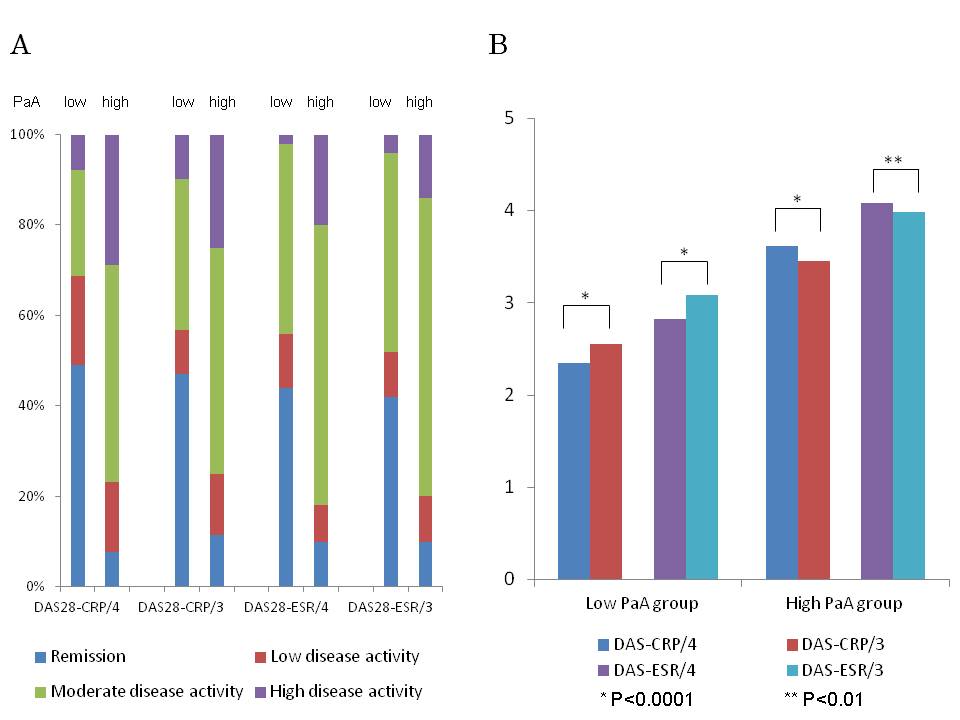Session Information
Session Type: Abstract Submissions (ACR)
Background/Purpose: Recently defined remission criteria of rheumatoid arthritis (RA), Boolean criteria or Simplified Disease Activity Index (SDAI) <3.3, requires considerably low rating not only of physicians' assessment (PhA) but also of patients' assessment (PaA) of the disease. However, it is very often that remission cannot be achieved or maintained because PaA does not fulfill the requisite. Also, PhA and PaA often differ largely from each other, and it has been reported that patients tend to assess the state of disease mostly by pain.
Methods: One hundred and four patients with RA were studied. Tender joint counts (TJC), swelling joint counts (SJC), and PaA as well as PhA by 100mm of Visual Analogue Scale were clinically evaluated. After the patients were divided into two groups according to PaA, either lower or higher than the median value, the two groups were compared in terms of age, duration, functional status, history of joint surgeries, comorbidities, prescribed medications, and laboratory data such as C-reactive protein (CRP), erythrocyte sedimentation rate (ESR) and matrix metalloproteinase-3. Other clinical data as well as disease activity were also compared by SDAI and four types of Disease Activity Score 28 (DAS28) formula; either including CRP or ESR, with or without PaA. Moreover, the correlation between PaA and PhA was examined, and clinical and functional remission was evaluated by Boolean criteria and Modified Health Assessment Questionnaire <0.5, respectively.
Results: The average and median value of PaA was 23.9mm and 17.5mm, respectively. In high PaA group (>17.5mm), functional status was significantly poorer (Steinbrocker Class III and IV, 23% vs 7.7%) and comorbidities were significantly more (32.7% vs 13.5%), whereas age, duration, history of joint surgeries showed no differences. Prescription of non-steroidal anti-inflammatory drugs and corticosteroid was significantly more often in high PaA group (67.3% vs 36.5% and 63.5% vs 28.8%, respectively), but there was no difference in that of methotrexate and biologics. TJC, SJC and PhA were significantly more in high PaA group (5.0 vs 2.4, 3.1 vs 1.3 and 30.4mm vs 16.2mm, respectively), whereas all laboratory data studied exhibited no differences. PaA and PhA significantly correlated with each other (r=0.57). All indices of disease activity were significantly higher in high PaA group (DAS28, Figure-A), among which DAS28, either including CRP or ESR, was significantly higher in low PaA group whereas lower in high PaA group, when PaA was excluded from the formula (Figure-B). Both Boolean and functional remission rate were significantly low in high PaA group (0% vs 35.3% and 55.6% vs 80%, respectively), but 19.2% of the patients in high PaA group would have achieved Boolean remission only if PaA had fulfilled the requisite.
Conclusion: Since PaA greatly influences the determination of disease activity as well as remission, it is very important to properly control the pain in RA.
Disclosure:
K. Shi,
None;
K. Miki,
None;
M. Yukioka,
None;
K. Ebina,
None;
S. Kaneshiro,
None;
H. Yoshikawa,
None.
« Back to 2013 ACR/ARHP Annual Meeting
ACR Meeting Abstracts - https://acrabstracts.org/abstract/patients-assessment-of-the-disease-greatly-influences-the-determination-of-disease-activity-and-remission-in-rheumatoid-arthritis/

